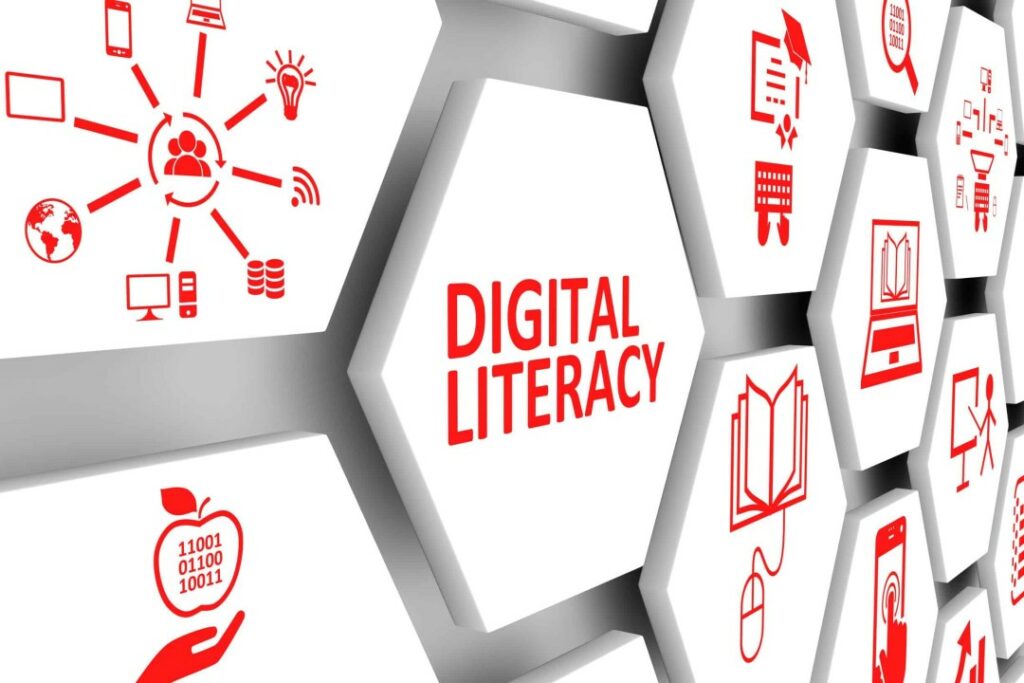In the 21st century, digital literacy is as important as reading and writing. It means being able to use technology to find, evaluate, create, and share information, which involves both thinking and technical skills. As our world becomes more digital, knowing how to use digital tools is essential for personal, educational, and career growth. This blog looks at why digital literacy matters today, its benefits, the challenges people face, and ways to improve digital skills.

What is Digital Literacy?
Digital literacy is more than just knowing how to use a computer. It includes a variety of skills such as:
- Basic Computer Skills: Knowing how to use hardware and software, navigate the internet, and utilize various digital tools and platforms.
- Information Literacy: The ability to find, evaluate, and use information effectively from digital sources.
- Communication and Collaboration: Using digital tools to communicate and collaborate with others.
- Content Creation: Creating digital content, such as writing blog posts, creating videos, or designing graphics.
- Critical Thinking: Analyzing and evaluating the credibility of digital information.
- Online Safety: Understanding how to protect personal information and navigate online environments securely.
The Benefits of Digital Literacy
- Enhanced Educational Opportunities: Digital literacy provides access to many educational resources. Online courses, digital textbooks, and videos allow for self-paced learning from anywhere. Students and lifelong learners benefit from a wide range of materials and interactive tools that improve learning.
- Career Advancement: In today’s job market, digital skills are essential. Employers want candidates who know how to use digital tools. Digital literacy improves job prospects, career growth, and competitiveness. Skills like data analysis, digital marketing, and software knowledge are highly valued.
- Improved Communication: Digital literacy helps effective communication today. Knowing how to use email, social media, and collaboration tools lets people connect, share ideas, and work together easily. This is crucial for remote work.
- Empowerment and Inclusion: Digital literacy gives people access to information, services, and opportunities. It helps bridge the digital divide, allowing underrepresented communities to participate more in society and the economy.
- Informed Decision-Making: Digital literacy helps people tell incredible sources from misinformation online, which is key for making informed decisions about health, finances, and other important life areas.
Challenges in Digital Literacy
- Digital Divide: Despite the widespread availability of digital technology, there is still a big gap between those who have access to these tools and those who do not. Factors like income, location, and education can affect who gets to use digital resources.
- Rapid Technological Change: Technology changes fast, and staying updated with the latest tools and trends can be tough. It requires ongoing learning and adaptation to keep up.
- Security and Privacy Concerns: Using digital technology can be risky, with dangers like cyber attacks and data leaks. Knowing how to stay safe online and protect personal information is a key part of digital literacy.
- Misinformation: The internet has a lot of misinformation and fake news. It’s important to develop critical thinking skills to check if information sources are reliable.
- Technical Complexity: Not all digital tools are easy to use. Complex technologies can be hard to handle, especially for older people or those without much tech experience.
Strategies to Improve Digital Literacy
- Education and Training: Schools should teach digital literacy to help students learn essential skills early. Adult education and community workshops can also offer important training.
- Access to Technology: It’s important to increase access to digital tools and the internet. Public libraries, community centers, and government programs can help provide these resources to those who don’t have them at home.
- Continuous Learning: Encouraging a culture of continuous learning is important. Online courses, webinars, and tutorials can help individuals stay updated with the latest technological advancements.
- Critical Thinking: Teaching critical thinking skills helps people judge the reliability of digital content. Learning to check facts and spot biases is key in understanding the digital world.
- Collaboration and Support: Peer learning and mentorship are good ways to boost digital literacy. Building networks where people can share knowledge and resources helps create a supportive learning environment.
- Focus on Online Safety: Education on online safety, privacy settings, and cybersecurity is important. Knowing how to protect personal information and avoid scams is a crucial part of digital literacy.
Conclusion
Digital literacy is essential today, affecting everything from education and careers to personal growth and making smart choices. Although there are challenges, specific strategies can help close the gap in digital skills, ensuring that everyone can learn these important abilities. By supporting digital literacy, we can build a more informed, connected, and inclusive society where people can confidently and effectively use digital technology.
